When analyzing the argument that Melissa King discusses in the article, some of the examples that she mentioned were a little farfetched. I agree with what she was saying in regards to her statement on “nobody should be required to read or listen to content if they do not want to”, however, when she used an example of someone having PTSD to trigger their anxiety—that was far left. This small issue, I do believe that King makes some valid points in regards to internet censors and content moderation. I believe that those who are involved heavily with the internet—specifically the millennial generation—are too sensitive to what they see online. Cyberbullying is an issue that we need to take on with full force, cyberbullying can be prevented by not only content moderation, but also the fact that one who is being cyberbullies can simply remove themselves from the situation by logging off whatever social media they are being targeted on. By doing this, Many cyberbully cases can simply fade with time and also.
With online abuse specifically, I believe that it is one-hundred percent avoidable. There are so many opportunities for content moderation such as deleting the app that you are using or using a blacklist feature on the social media platforms, which is something that Melissa King also suggests. I also believe that using women as targets on these social media platforms is wrong and unjust, and is a double standard in today’s media society. For instance, a female who posts a risqué photo online will be slut-shamed online as opposed to a male who can post something similar. It is an issue in popular culture and this sexist attitude on social media apps is just wrong. However, using these targets as a ploy for attacks online through slut-shaming, is just downright terrible. I believe that using content moderation and a blacklist feature is perfect for these situations, as it would indeed prevent someone from being attacked online.
I feel as if Melissa King should have discussed this more in her entry, as I would have loved to learn more about this certain issue. With the article itself though, I don’t think that people with PTSD should even be using a computer and logging in online in the first place, so that is something to consider when looking at social media attacks online. This is the prime issue to consider. Even though cyberbullying is a heinous crime and shouldn’t be taken lightly, I feel as if someone with an issue with mental disorders should probably stay off the internet in its entirety, specifically the social media realm of the web. Instead of using that time online, they could be doing something more productive such as getting the help they need to treat their mental disorder.
Melissa King did a fabulous job in presenting the issue of media blacklisting and moderation, and fully agree with what she had to say about the detrimental effects a negative trigger from an online source can have on a person’s mental health.
In this article “Color Walking” by Phia Bennin and Brendan McMullan. The starting point of the subject begins by explaining the actual experiment of color walking its self. The introduction provides you with the insight that the color walking experiment expertly developed. Continuously, the authors begins unfold the experiment by drawing the reader to visualize a color of their choice. Once the reader has taken the moment to visual their color, the virtual experiment begins. Now, the authors round out the opening concept of color walking by utilizing real world examples such as “the red of a bicyclist’s shorts” and ” the sunburn on a woman’s shoulders”.
Once the concept of color walking was established in the initial paragraph. Readers were now able to expand their understanding of color walking by being able to establish a flexibility within the experiment to transition from color to color. The new established flexibility to switch colors produces a virtual linear patterns between the various colors. The Preliminary visual pattern was horizontal. This lead the spectators eyes to move from left to the right lavender bag. A secondary visual pattern that developed was the yellow cab which guided the spectators vision downward from a “yellow cab” to a “side street”. The final visual example drifted from the linear pattern explained in the previous visual demonstration and introduced greater variation spotting with “a green pistachio ice cream cone” to landing in a literally green space: a park.
After the article has finished explaining the all variations of the experiment, a web-based tour was embedded into the article. The embedded activity simulated a sunny day in New York city. The different times slot displayed various items discovered throughout the day. All thought the day color choices such as blues, purples, and pink were selected in small insignificant finds that might otherwise be overlooked.
The overall experience after the virtual tour resulted in the lesson of viewing the world in living color. The article began concluding its final thoughts by beginning the article how it started. A reader’s experience of exhausting the whole day carefully monitoring all colors and objects passing by. This final mental simulation infused the reader with the authors’ perception of the befits associated with the color walking. Also the authors drives their points home about color walking through utilizing suggestions for the readers who will take on the color walking experiment on their own.
Bennin and McMullan, exits the article with their final comments on how to successfully complete a the color walking experience. The authors prescribe three golden rules. The opening rule concerns solely about concentration. By the reader taking a deep breath and focus on creating a space where no distractions are present from no cellphone to silence; which results in “uninterrupted eye time”. Post “uninterrupted eye time”, the reader can now focus on selecting a color they fancy the most. When taking time and consideration for the color choice, the reader is able to experience a more concrete and fulfilling experience of the experiment. The final tip pertains to the reader exercising their flexibility. If the reader become bewildered in the process of trying to following a specific color; thankfully, they can take a deep breath, blink multiple times and simply select a new color.
Color walking is an interesting and exciting avenue to explore a city, while also experiencing an personal pulse on the built envirmoment.
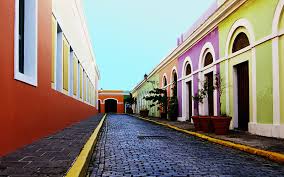
Color Walking
The built environment of a city consists of various elements that help produce a conducive atmosphere for all that inhabit the space. In the physical environment, the placement of structures ranging from business to domestic, establishes a tone which contributes to the overall balance between commerce and commonwealth. Recreational resources induce fellowship between residents, churning the feeling of cohesiveness throughout the environment. Population size in combination with diversity reveals the built environment’s capacity to provide its residence with individual amenities; while, still encompassing the conventional neighborhood vibe. The city of Decatur located fifteen minutes from downtown Atlanta has captured the finite details of an “ideal” built environment. Decatur’s mastery of a balanced built environment has produces an overwhelming sense of community that surrounds the space. Downtown Atlanta’s built environment strives to produce a “Ideal” perception of community throughout the downtown specter. However, the built environment of Downtown Atlanta is an ever growing built environment. The outcome is a city trying to satisfy the contributing aspects of a built environment without having a steady hand on the inclusive outlook of the space. As a result, Downtown Atlanta’s built environment processes a weaker sense of community.
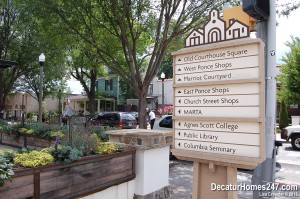
City of Decatur

Downtown Atlanta
Upon first glance of the two built environments, the structure provides the most prominent contrast. The city of Decatur’s structures are focused around the community. According to http://www.decaturil.gov Decatur’s zone ordinance prohibits buildings within the city limits to be taller than two stories or thirty- five feet in vertical height. The ordinance does allow one expectation; a structure may reach maximum of sixty Feet in vertical height. A regulation regulation was constructed for buildings with a maximum height of sixty-feet that requires their boundary line in residential areas to increase by a foot for every building over a vertical height of thirty-five feet which extends to a maximum of sixty-feet. Downtown Atlanta’s structures focus less on the community need and appeal to the business district. Wikipedia’s database rendered, the tallest building in downtown Atlanta is the Bank of America Plaza Building. The building stands at remarkable fifty-five stories or one-thousand and twenty – four feet, the building the eighty-seventh tallest building in the world and tenth tallest in the country. The extreme height of this building is classified as a skyscraper which promotes a busy city individual success orientated environment.
The structural component of the built environment extends further than the buildings within the community. But also the road infrastructure places a role in the greater sense of community. Within downtown Decatur, the city’s main roads such as DeKalb Ave and Ponce De Leon Ave NE are designed for traffic to flow in both directions. Also each road possesses no more than three lanes on either side of the margins. This results in a greater accessibility for drivers and also with small business that occupy either side of the street. By both side of the street being accessible more space for small business are available as well as parking. Downtown Atlanta also possess hub roads within the city. The most well known streets like piedmont avenue and Courtland street are one-way. These one way streets are large and fast with up four or five lanes. The structure of the roads limits the accessibility and only caters to businesses and cooperation that’s can afford the pace and the parking for residents. By limiting the accessibility the a deeper sense of community is weakened.


Community resources of the built environments are also a major contribution to the “ideal” balance of the built environment. Green space is key built environments. The city of Decatur has taken the concept of a green space and personalized the space to be utilized for residence to connect with one another. I was able to participate in this fellowship firsthand when I visited Oakhurst Garden in downtown Decatur. The Oakhurst Garden is set up into individual plots. These plot are managed by community residents who pay annual dues and contribute their time throughout the year to maintain the garden’s upkeep and vegetation. As a result, the community residents are allocated their own individual plots to grow any kind of produce, fruits, or other vegetation on their choosing. Oakhurst garden serves as green space to provide the resident of this community with a haven to grow an array of vegetation ranging from seasonal fruits and vegetables to decorative flowers. The Oakhurst garden provides the community with true sense of locally grown produce while, still contributing the environmental benefits while living in an urban neighborhood. Downtown Atlanta most prominent green space is piedmont park. Piedmont park is Atlanta’s prime recreational. The park hosts many events such as yoga in the park, green market, healthy living fitness. These various activities in the park, do help draw residents in the downtown to come together and experience natural camaraderie. The activities help create a deeper sense of community. But the outreach could miss the target audience and draw residents that don’t actually live in the areas. Ultimately creating try to produce a greater sense of community but still not reaching the community mark.
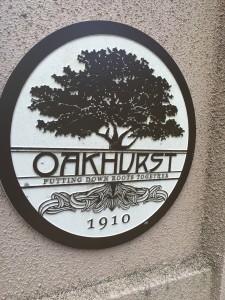
Community Seal

Business sectors of a built environment expand the the sense the community by determining how to supply the community’s residents with necessities and commodities. When environments develop a solid foundation for business the end result is a stronger more prosperous community. Decatur has set a strong foundation for the small business within the city. Small businesses in Decatur that are thriving to this success is the Decatur business association. This association has been around for thirty years and acquired more than four-hundred and fifty members of diverse business to join this alliance. Some of the businesses in the all association range from financial institutions, arts groups, organizations and private individuals. This association purpose strives to ensure to the that business in the city of Decatur is attractive and able to attract the residents that live in the community bust also visitor that pass through the city. Also the Decatur Business alliance has such a wider variety of member; the association is able to keep a live pulse on community what cohesive ideas the business owner and residents feel will enhance the city of Decatur while still maintaining a close knit community.
A small business in Decatur I visited was Dancing Goats coffee shop. This small coffee shop caters to the communal feel by providing outdoor furniture that residents are able to tie their pets’ leashes on while taking a break to sip coffee. The interior of the shop has a very intimate experience with walls and lighting warms colors. Dancing Goats coffee shop provided me with a personal feeling of how the city of Decatur strives to be the best constantly preserve the sense of community.
The Downtown Atlanta is dominated by big business. Downtown is home to some of the largest cooperation in the world. Corporations like Coca-Cola and Delta are well known businesses internationally. Last year Coca-Cola that earned a whooping 180 billion dollars. The major corporations set a tone of Big dog and little dog, which leaves, small business has very limited place. Although major corporations do set the tone small business finds ways to prevail and make an impact on residents in that space. Small businesses in downtown find their niche through supplying services like dry cleaners, nail salons and specialty boutiques. Many times their target customer are the business employee that occupy the major corporations. These small business depend on consumers who work or live around the large corporations that help supply the small businesses. This complex between small business and large corporations. Since overall weakens the community relationship due to the people who occupy the common place are not living residents of the downtown community.

Coca-Cola
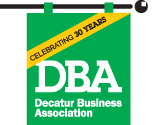
Decatur Business Association
The City of Decatur’s great sense of community has set the example of an “Ideal” community. The City provides, the community with road accessibility and structures that highlight community advancements. Also gathering green spaces like the Oakhurst community garden, display the city’s of decatur awareness about being environmentally- friendly. While educating members of the community on how be positively influence the green planet we live on. These elements of the built envirmoment ultimately produce a diverse atmosphere. Atlanta’s Downtown community has not yet been able to grasp these elements and provide residents of their community with the same holistic experience.
All hope for downtown Atlanta’s sense of community is not lost. The downtown area strengthen its sense of community by taking intuitive to implement programs. First is the structure of converting one- way streets into two-way streets. This will provide more accessibility for residence to to travel from place to another. Additionally by having more two way streets more more business owners would be able have their businesses on main road access streets. Also stating that Downtown Atlanta could the street access be to have spot specifically designated for small business and others for large corporations.
Environmentally, Downtown Atlanta can utilize the green space the city already owns host specialized community events. Fitness sessions such as yoga at the park can be exclusively promoted to only downtown residents. Also, downtown can construct in city parks small plots for community residents to grow their fruits and vegetables similar to the city of decatur. The program could have catchy title such as “Veggie Time” or ” Once Upon A Tomato”. This will allow residents to participate in fun community programs that could educate and strengthen relationships in the community.
Downtown Atlanta to promote the formation of a small community business alliance. By Atlanta having small business alliance, businesses can finally step out and provide services for not only to corporate consumers but to to community residents as well.
Work Cited:
“CITY OF DECATUR ZONING ORDINANCE.” 14 Dec. 2014. Web. 27 Apr. 2016.
Parham Kordsmeier, Kate. “Fortune 500 Companies Headquartered in Atlanta, GA.” About.com Travel. 24 Sept. 2015. Web. 27 Apr. 2016.
“Building a Successful Business Community Together.” Decatur Business Association. 1 Jan. 2016. Web. 29 Apr. 2016.
Forbes. Forbes Magazine, 1 May 2015. Web. 27 Apr. 2016.
Wheatley, Thomas. “Should Some of Intown Atlanta’s One-way Streets Become Two-way? | Atlanta News & Opinion Blog | Fresh Loaf | Creative Loafing Atlanta.” Creative Loafing Atlanta. 14 Sept. 2011. Web. 27 Apr. 2016.
Coca-Cola Symbol. Digital image. Wikia. 26 May 2014. Web. 29 Apr. 2016.
Known. Decatur Business Alliance. Digital image. http://decaturdba.com/. 1 Jan. 2016. Web. 27 Apr. 2016.
Known. Piedmont Park. Digital image. Landscape of Piedmont Park. 16 Sept. 2010. Web. 27 Apr. 2016.
Thesis: The built environment of the city Decatur greater sense of community than downtown Atlanta.
Introducation:
The city of the Decatur is located 15 minutes away from the Heart of Downtown Atlanta.
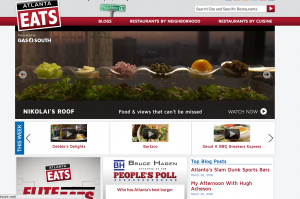
Home Page
- This is the first page that appears, once you have typed in the the url. The home page consist of bold colors such as reds and whites with bold black trimming. The layout is in visual layers. First layer of the website is slides showing various cuisines and food styles. Next layer another is of multiple videos showing how the different cuisines are prepared, cooked and eaten throughout metro-Atlanta area. The final layer is social media. In this final layer multiple compartments are displaying friendly poll surveys and top article pieces mentioned in twitter post.
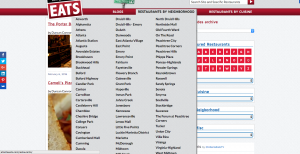
Drop Down Menu
2. When observing the page moving my cursor over the different tabs, a drop down menu appears. In this drop down menu there are a list of all the place in metro Atlanta that Atlanta Eats has reviewed. The range of places spand from Luckie-Marietta:street which is located just south of Georgia State’s class building Aderhold all the way to Athens- Home of the University of Georgia.
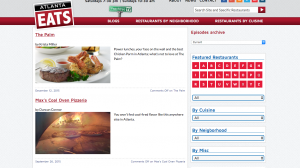
3. After browsing through all the different locations I choose Luckie-Marrietta district Due to its proximity to Georgia State. The next web page popped up with the with the various places that had been interviewed by the food review site. Some of the choices were Palm which is a restaurants that serves hard meals as well as Mac’s Coal Oven pizzeria.

4. Next once clinking the name of the restaurant it brings it to a link that shows a video about what the restaurant has on their menu and also the atmosphere of the restaurants and the type of people that attend. The link page also consist of others ads on the from company like GAS South which in returns bring more revenue to the overall site.

Article of the Week
5. The final article was the article of the week. This article is located on the side page and the page linked to a piece that talked about the best cuisine of the week.The article describes the taste and the overall quality of the actual food.
Full Summary
The website has an overall hardy look with bold colors and appetizing meals on the home page. The home page immediately encompasses what the television show is about. Initially the subject of food is brought the page. The homepage faintly resembling the layers of a cake. This cake-like structure contained vital information within each of the layers. The layers’ placement of being first visual and providing the site visitor with a “Taste” of what foods are reviewed on AtlantaEats.com. Additionally, the secondary layer explains in depth the various dishes prepared and their ingredients. The final layer is combination of social media platforms and also advertising. The look of the home page transitions into the following links that direct the visitor to the section of the page where they can find restaurants in their areas that were reviewed. Once the cursor is placed over the link the once black word highlights red and page is clicked. This now directs you to the individual restaurants review page revealing the specialty dishes on each page as well as more general information about the reviewed website. Also in the margins of the screen there are multiple tabs leading to links with articles on various culinary pieces with trendy headlines also in bold black lettering and the same hardy colors matching the homepage background. The overall look and designed of the website sets the view for how Atlanta food and culture are experienced through metro-Atlanta.
- Lizarralde, Gonzalo, et al. “A Systems Approach To Resilience In The Built Environment: The Case Of Cuba.” Disasters 39.(2015): s76-s95. Academic Search Complete. Web. 5 Feb. 2016.
In the article “A Systems Approach To Resilience In The Built Environment: The Case Of Cuba.” a team of researchers examined the systematic theory to resilience of the Cuban National approach to natural disasters within the built environment. Researchers conducted a study to investigate the Cuban National approach theory through the elements of risk reduction, efficient reconstruction strategies, and the adaption to a changing environment. The results of the case study indicated that the Cuban National approach theory successfully decreased the number of deaths during a natural disaster by efficient health- care services, high levels of preparation and training, a warning program trusted by the population, and critical trust between government officials and the civil society. Cuba’s model highlights the contradiction to the stereotypical theory that large amounts of funds are what prepare countries/cities for natural disaster. The Atlanta built environment can reflect upon the Cuban model to better understand the critical framework to execute a systematic plan long before a natural disaster ever approaches.
- Beer, Chris. “The Contingent Public Value Of ‘Good Design’: Regulating The Aesthetics Of The Australian Urban Built Environment.” Australian Journal Of Public Administration 73.2 (2014): 282-292. Business Source Complete. Web. 5 Feb. 2016.
Chris Beer, An Economic Development Directorate at ACT Government and University of Canberra conducts an evaluation on Australian architect on the premise of what public value recognizes as beautiful or “Good Design” within the built environment. Beer explains the origin of architectural beauty originates as far back as the ancient geeks similarly, like the western “Beautiful City” movement in the late 1800s – rapid growth in population placed significant opinion to the appearance of the sprouting built environment. Today’s modern building design can be determined by the economic area associated with the structure. Beer examines Australian jurisdiction, through placement of regulations within certain areas for the attractiveness of specific built environments. Also regulation utilized moderately can benefit the aesthetic look of the built environment. Atlanta’s built environment is steadily growing the attributes of the city’s continue to become more appealing. Moderate regulation and wise building planning will allow Atlanta to have a greatly designed built environment.
- Hirsch, Jana A, et al. “Built Environment Change And Change In BMI And Waist Circumference: Multi-Ethnic Study Of Atherosclerosis.” Obesity (Silver Spring, Md.) 22.11 (2014): 2450-2457. MEDLINE with Full Text. Web. 5 Feb. 2016.
In this article, the authors discuss how the built environment affects BMI, waist Circumference, and the difference in these factors in diverse groups of adults. The study conducted researched to display that Americans are less likely to create built environments where critical elements like grocery stores and other shops located within 10-15 minutes walking distance. By American built environments recreating spaces that encourage more walking the obesity would decrease. Furthermore, the article examines that built environment cultures that promote active ways of living experience an overall healthier population in the built environment. Atlanta’s built environment can create establishments that promote health and navigate individual citizens to an enhance state of living.
- In Aydin Turkey at the university of Adnan Menderes researches conducted a study on the affects of green spaces and its effects the mental health of high school students. The experimenters create a restorative environment which is a space that “promotes, and not merely permits, restoration.” (Hartig 2004). The experimenters prepared the campus green space with the ideal nature elements such as a bushes, shrubs, and other natural features. A total of 265 students were introduced to the green space. The results rendered that when many of students were introduced the newly built green space, they felt this new place a physical and mental retreat when doing work or studying. The study and implementation of this green space at a primary educational level displays how stress alleviations are viable at all stages of life. This green space study conducted on Turkish high school applies to the built environment through further magnifying the growing need to balance natural learning spaces in an urban environment centered around learning.
“How Is High School Greenness Related to Students’ Restoration and Health? – 1-s2.0-S1618866716000078-Main.pdf.” Accessed February 24, 2016. http://ac.els-cdn.com.ezproxy.gsu.edu/S1618866716000078/1-s2.0-S1618866716000078-main.pdf?_tid=35bb44c4-da8a-11e5-8acd-00000aacb35d&acdnat=1456272464_e724bbf5527bc4810f2a3a7873f18341.
- In this article the topic of discussion is the revitalization of urban area so that the social and economic elements of the community can prosper. At the beginning of the article researches identify that many urban communities are now experiencing a social shift stemming from the changing demographic elements such as race, job growth and the introduction of more businesses. This shifting urban built environment is now a “network society” (Kelly, 1). During their research experimenters establish the concept that these now revitalized networking society are no longer cities built on singular industrial jobs that dictate the communities progress. The network communities provide a space for various job opportunities that can benefit the community as a whole. The researcher also noted that spatial placement of vital places in the community are what help create the sense of wholeness. This article apply to the built environment project by demonstrating that area in urban environments can be revitalized as well as provide a sense of safety within an urban area.
“Collaborative Digital Techniques and Urban Neighborhood Revitalization.” Social Work 56, no. 2 (April 2011): 185–88 4p. doi:sw/56.2.185.
- In this article researchers Hillsdon, Panter, Foster, Jones examine how accessible green spaces are in urban environments. The researchers explore how undistributed amount of green space allocated in cities. The experiment was conducted in Norwich, UK. The method in which the experiment was carry out was through the calculating the distance of the green spaces to people of various economic background status. In addition to testing how much of the green space is accessible, the researcher also learned that that a reduction in greens space affects the amount of recreational physical activity in these areas. Once the experimenters conducted the experiment the results render, that green spaces could not be full conclusive that economic status is associated with the amount of green spaces in an urban environment. The lack of green spaces in urban areas inspire a lower level of physical activity than those who live in an area with access to more green spaces. The absence of green spaces in urban areas heavily impact the lives of those who live the area in negative ways residents may not notice. This study proves the built environment has an impact on recreational physical activities.
University of Bristol, Tyndall Avenue, Bristol, BS8 1TP, UK
University of East Anglia, Norwich, NR4 7TJ, UK
University of Oxford, Headington, Oxford, OX3 7LF, UK
Available online 25 October 2006
- In an article written by Jon Hillkevitch, of the Chicago Times, Jon writes about as the city of Chicago’s built environment expands so does advocacy for more bike lanes. A Chicago bike advocacy group states that “by 2019 fifty miles of bike lanes will be added to Chicago’s streets and the project will be fully funded federal l grants.” As a result of this new bike lane intuitive, an alliance has been created for bike riders. The alliance’s goal is to bring forth a plan to create one-hundred and eighty miles “low-stress bike routes” that are similar to an off-road trial. These new type of trials with protected lanes will encourage more Chicagoans to ride their bicycles, while also alleviating the hesitation that most citizens have about riding bikes in busy cities. The city’s realization for the bike trials begun when the League of American Bicyclist conducted a survey in which they found that 1.7 percent of Chicago’s population commutes by Bicycles. The bike population is over twenty-one thousand people making they city’s bike commuters the second highest conduced by the group. The increase bike trials will connect to local and neighborhood stores and schools. Additionally, the trails will pass through some of Chicago’s landmark attractions like lake-shore drive and Wicker Park. This article is related to Atlanta’s built environment through being a blue print of how a growing city should look at transportation for all that occupy the space whether resident or commuter. Also with Atlanta’s constantly growing built environment but lack of transportation accommodations, an expansion of bikes lanes can encourage further outreach within the downtown and midtown areas.
Tribune, Chicago. “Build More and Better Bike Lanes, Cycling Advocates Urge Chicago.” Chicagotribune.com. Accessed March 26, 2016. http://www.chicagotribune.com/news/columnists/ct-bike-lane-network-getting-around-met-1012-20151011-column.html.
- “Under Pressure From Uber, Taxi Medallion Prices Are Plummeting – NYTimes.com – Uber_Taxi_Medallion_Prices.pdf.” Accessed March 26, 2016. http://www.sas.upenn.edu/~holgers/urban/Uber_Taxi_Medallion_Prices.pdf.
In this article written by Mark Turmoil, of the New York times, He discussed the how Uber drivers have caused taxi prices to plummet in New York City Since 2013 when the app driven car service company uber gain its popularity. New York City tax prices fell by a whopping 17 percent. Many big cities taxi companies operate under a medallion system. The medallion system process is, Taxi drivers must own or rent a medallion to drive the taxi. The city only issues a fixed number of medallion which can range from a highpoint of 475,000 to a lower end of 350,000. This hefty prices for taxi driver to pay for the taxi car results in the higher wages for the passengers. When broken down into one a one-way taxi trip in a major city can cost close to 26 dollars; in comparison, the same Uber one-way trip is less that 12.50. Thus, the price of Medallions are being placed at prices much lower. Low medallion sales have resulted in many taxi companies and owners going bankrupt simply due not being able to compete with the extremely low fares of uber. Low Uber fares have resulted innovation from taxi drivers. Since June of 2013 “boro taxis” also known as green taxis only pick up fares boroughs that are outside of Manhattan and north of Manhattan, furthermore, boro taxis’s selective driving location allow them to competitively compete with uber fare rates. Yellow cabs have seen this innovation and taken part and tried to reduce their fares for shorter trips. This articles is related Atlanta’s built environment through recognizing shift in transportation within technology. While also taking steps of allowing both taxi serviced to coexist.
- Leccese, F. “Remote-Control System of High Efficiency and Intelligent Street Lighting Using a ZigBee Network of Devices and Sensors”, Power Delivery, IEEE Transactions on,On page(s): 21 – 28 Volume: 28, Issue: 1, Jan. 2013
This article by Y Wu discusses the placement of street lamps in china’s small to medium populated cities. Many of the street lamps are controlled by optical or time-optical control methods. The lighting systems has challenges not on the lighting its self but on the precision of what lights should be synchronized to be lit at night time. Data taken from muliti-sensing survey revealed that by systems being synchronized with the rising and setting of the sun, the cities could be lit at a more seamless rate. More innovative street light controllers were installed by photoelectric lights and optical controlled lights to process the lighting of the streets. Additionally, the new street lamps have a “wake-up” condition. The “wake-up” component registers sunlight absorption and movement from an increased amount of pedestrians, which results in the light being able to shut off on its own. Since the implementation of the new smart lights the crime rate has gone down and energy consumption has decreased as well. The LED lighting within the street lamps have decrease the amount of money having to be spent on continuous replacement of light bulbs in theses urban environments. The cost effectiveness has also allowed for the cities to increase the number of smart lamps being installed due to the lamps technology. These innovations have also led to the street lights becoming more self-sufficient and producing a more reliable network of lighting in these cites. This articles relates to Atlanta’s built environment by investigating more sufficient lighting in the city while also creating an more eco-friendly and crime free environment.
10. In this article written by authors, William Kent, Patti Shock, and Robert Snow. They discuss how the major southern cities with major shopping complexes attract more tourist and create an overall boost in the economy. They study was designed to test this theory at Atlanta Convention center and Visitor Bureau. The process of the study was carried out through asking tourist “what they enjoyed most about they’re location during their trip?” The tourist answered 75 percent of because they located near major shopping center. Their location made their trip more pleasurable. This is relative to the built environment of Atlanta because this is a direct result of Atlanta’s shopping scene as it develops while also recognizing the shopping scene as a major economic contributor.
Kent, William E., Patti J. Shock, and Robert E. Snow. “Shopping: Tourism’s unsung hero (ine).” Journal of Travel Research 21.4 (1983): 2-4.

Inside Layout
- Upon first stepping into the coffee shop, I immediately noticed cozy lounge area. The area created an atmosphere of a traditional coffee shop, while still providing an open layout. The hardwood floor and neutral colored walls warmed the room and mentally placed you in the setting of being inside a cup of coffee. Also the coffee shop utilizes their lighting by taking advantage of the natural light from the wide glass windows, in combination of fabric canopy coverings that hang over the industrial lights of the building.
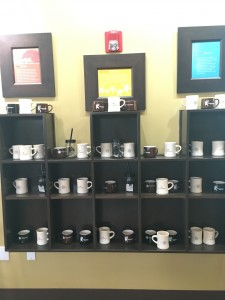
Merchandise Display
2. After noticing the initial layout of the coffee, I became aware their merchandise display. The framework material of the display remained consistent with the hardwood theme. The hardwood’s color is much richer than the hardwood floor, which allowed the shop’s retail items pop against the dark background. The items sold consisted of various mugs ranging from giant ceramic mugs to temperature controlled tumbler cups.
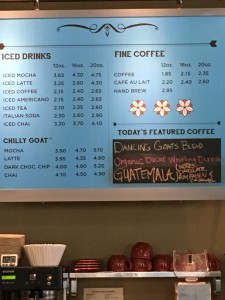
Menu
3. The Dancing goat’s menu consist of a selected amount of items. The format of the menu comprised of three main sections- Iced drinks, chilly goat, and fine coffee. Under each main section were the various styles of coffee each containing less items than the previous section. The menu’s price ranged from the cheapest item being an iced tea for $2.10 to the most expensive item being a specialty mocha drink price at $4.30. The items are priced very economically in comparison to chain coffee enterprises like Starbucks.

Sitting Area
4. Once I my order had been place, I ventured throughout the coffee shop to find a place to sit. I landed on a small dark stained coffee table located in the corner of the coffee shop. On each side of the table, high sitting wooden stools were placed. This allowed the table to become an aid instead of a visual obstacle. On the wall behind the table, were two locally created paintings. The left painting was produced through the medium of water color, while the right was produced by oil paint. Each of the painting added a peaceful element to my sitting experience.
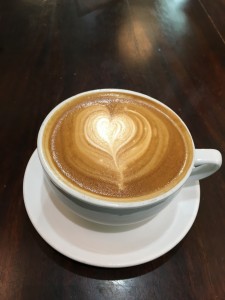
Latte’
5. Now with a place to sit, I proceeded back to the counter to receive my latte’. The latte’ itself was placed in a giant cappuccino style cup. The heavy cream that is customarily present in a latte’ was expertly crafted into a heart. As the cream expanded in the cup, heart ringlets started to form and my anticipation to sip was finally granted..

Entrance of Coffee Shop
My interior built environment location was Dancing Goats Coffee Bar located at 419 W Ponce de Leon Ave in Decatur, GA 30030. The coffee shop’s external illusion of limited space is shattered when stepping into the coffee shop and experiencing the spacious layout. The interior design provides an intimate feel through the selection of warm colored flooring, fixtures and walls. The high ceiling also allow noise to be kept to a minimum, while natural lighting illuminates the interior of the building. Dancing goats also places their merchandise in wooden fixtures that compartmentalize their product ranging from t-shirt to tumbler cups. All of the merchandise contained the same Dancing Goats’ logo, but displayed in various methods depending on the actual item its self. Their menu consists of a select number of items; consequently, the menu contains less than twenty items total. Although, Dancing Goats may lack variety, this factor is compensated through their economical pricing. All items on the Dancing Goats menu is less than five dollars, which delivers an aesthetic high priced experience at an economical rate. During my time at the coffee shop I purchased a latte’. The coffee brew of the latte’ itself was produced by the small business owned coffee brewery, Batdorf and Bronson. Upon tasting the latte’ I experience a strong and robust taste after each sip. To accompany the robust sip was the heavy cream that smooth out the edges of bitterness that might have existed within the latte’. My experience of the coffee shop was pleasant and a new perspective into coffee shops outside of the mundane chain coffee establishments such as Starbucks. I plan to make Dancing Goats Coffee Bar in Decatur a regular visiting place, where I can indulge in a great atmosphere and even better coffee.
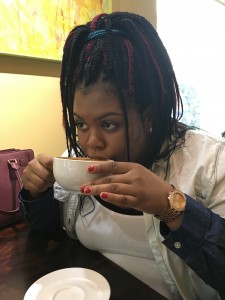
Sipping Latte’
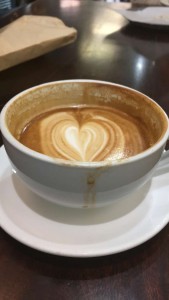
Sipping in Progress.

Finished Product
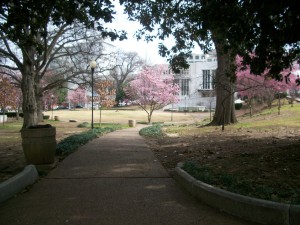 In this article researchers Hillsdon, Panter, Foster, Jones examine how accessible green spaces are in urban environments. The researchers explore how undistributed amount of green space allocated in cities. The experiment was conducted in Norwich, UK. The method in which the experiment was carry out was through the calculating the distance of the green spaces to people of various economic background status. In addition to testing how much of the green space is accessible, the researcher also learned that that a reduction in greens space affects the amount of recreational physical activity in these areas. Once the experimenters conducted the experiment the results render, that green spaces could not be full conclusive that economic status is associated with the amount of green spaces in an urban environment. The lack of green spaces in urban areas inspire a lower level of physical activity than those who live in an area with access to more green spaces. The absence of green spaces in urban areas heavily impact the lives of those who live the area in negative ways residents may not notice. This study proves the built environment has an impact on recreational physical activities.
In this article researchers Hillsdon, Panter, Foster, Jones examine how accessible green spaces are in urban environments. The researchers explore how undistributed amount of green space allocated in cities. The experiment was conducted in Norwich, UK. The method in which the experiment was carry out was through the calculating the distance of the green spaces to people of various economic background status. In addition to testing how much of the green space is accessible, the researcher also learned that that a reduction in greens space affects the amount of recreational physical activity in these areas. Once the experimenters conducted the experiment the results render, that green spaces could not be full conclusive that economic status is associated with the amount of green spaces in an urban environment. The lack of green spaces in urban areas inspire a lower level of physical activity than those who live in an area with access to more green spaces. The absence of green spaces in urban areas heavily impact the lives of those who live the area in negative ways residents may not notice. This study proves the built environment has an impact on recreational physical activities.
University of Bristol, Tyndall Avenue, Bristol, BS8 1TP, UK
University of East Anglia, Norwich, NR4 7TJ, UK
University of Oxford, Headington, Oxford, OX3 7LF, UK
Available online 25 October 2006
In this article the topic of discussion is the revitalization of urban area so that the social and economic elements of the community can prosper. At the beginning of the article researches identify that many urban communities are now experiencing a social shift stemming from the changing demographic elements such as race, job growth and the introduction of more businesses. This shifting urban built environment is now a “network society” (Kelly, 1). During their research experimenters establish the concept that these now revitalized networking society are no longer cities built on singular industrial jobs that dictate the communities progress. The network communities provide a space for various job opportunities that can benefit the community as a whole. The researcher also noted that spatial placement of vital places in the community are what help create the sense of wholeness. This article apply to the built environment project by demonstrating that area in urban environments can be revitalized as well as provide a sense of safety within an urban area.
“Collaborative Digital Techniques and Urban Neighborhood Revitalization.” Social Work 56, no. 2 (April 2011): 185–88 4p. doi:sw/56.2.185.























 In this article researchers Hillsdon, Panter, Foster, Jones examine how accessible green spaces are in urban environments. The researchers explore how undistributed amount of green space allocated in cities. The experiment was conducted in Norwich, UK. The method in which the experiment was carry out was through the calculating the distance of the green spaces to people of various economic background status. In addition to testing how much of the green space is accessible, the researcher also learned that that a reduction in greens space affects the amount of recreational physical activity in these areas. Once the experimenters conducted the experiment the results render, that green spaces could not be full conclusive that economic status is associated with the amount of green spaces in an urban environment. The lack of green spaces in urban areas inspire a lower level of physical activity than those who live in an area with access to more green spaces. The absence of green spaces in urban areas heavily impact the lives of those who live the area in negative ways residents may not notice. This study proves the built environment has an impact on recreational physical activities.
In this article researchers Hillsdon, Panter, Foster, Jones examine how accessible green spaces are in urban environments. The researchers explore how undistributed amount of green space allocated in cities. The experiment was conducted in Norwich, UK. The method in which the experiment was carry out was through the calculating the distance of the green spaces to people of various economic background status. In addition to testing how much of the green space is accessible, the researcher also learned that that a reduction in greens space affects the amount of recreational physical activity in these areas. Once the experimenters conducted the experiment the results render, that green spaces could not be full conclusive that economic status is associated with the amount of green spaces in an urban environment. The lack of green spaces in urban areas inspire a lower level of physical activity than those who live in an area with access to more green spaces. The absence of green spaces in urban areas heavily impact the lives of those who live the area in negative ways residents may not notice. This study proves the built environment has an impact on recreational physical activities.